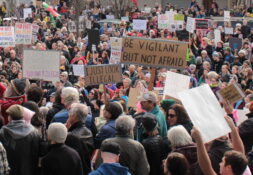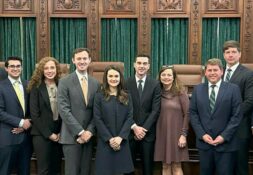Lecture presents dark history of communism
On Monday, Young Americans for Freedom hosted a lecture by George Harrison entitled “The Victims of Socialism.” Harrison discussed in-depth the communist regimes of the former Soviet Union, the People’s Republic of China, and Cambodia. Ominous music played in the background and photographs of the conditions during each regime filled the overhead projector of the large classroom.
Harbison, a financial executive, visits colleges and discusses the flaws of communism out of passion rather than profession. His talk is meant to combat what he sees as support of socialism that disregards its past failures.
“The pathology of Western intellectuals has committed them to an adversarial relationship with the culture of free markets and individual rights that has produced the greatest alleviation of suffering,” Harbison said. He worries about people supporting socialist ideology without understanding its past effects.
First, Harbison described in detail the extent of suffering, starvation, and political persecution of millions in the infamous Soviet Union, particularly under the leadership of Vladimir Lenin and Joseph Stalin. His presentation took students to the Gulag, forced labor camps in which millions of Soviets were detained, and into the mass starvation of an estimated eight million people. Photographs behind him showed mass graves from executions that characterized Stalin’s Great Purge, bodies piled up on top of each other, and skulls with holes through the forehead. Harbison, who estimated the death toll under the U.S.S.R. at 20 million, stated, “The magnitude of horror, death, and destruction brought about by Vladimir Lenin and Joseph Stalin as they ruthlessly imposed communism on Russia in the Soviet Union is beyond human comprehension.”
Harbison then presented Mao Zedong’s rule as head of the communist party in China. He noted similarities between the Chinese and Soviet tactics, especially the forced collectivization of agriculture and famine that followed. Stories of people turning to cannibalism out of desperation brought into stark focus the extent of the starvation in China under Zedong. He described the laogai camps, where political dissenters were punished with forced labor and reeducation programs. The cultural revolution that began in 1966 and lasted for ten years similarly used the youth as a force for pushing ideology, involving them into violence that Harbison presented in photographs as well.
Next, Harbison described Pol Pot’s rule in Cambodia and the starvation and murder of around 25 percent of the total population of the country. As he told of governments stopping people from foraging or fishing for food, he painted a picture of complete desperation in the audience members’ minds. Photographs showing the murder of teachers and intellectuals as well as descriptions of the burning of books and banning of religion stuck out in particular in a setting that is both academic and religious.
Harbison was strong in his condemnation of communism, calling it “an ideology that runs completely counter to human nature … [and] totally extinguishes human freedom and dignity.” Harbison condemned the ideology that he views as obviously flawed; he praised the forces that brought it to its end, specifically highlighting former President Ronald Reagan, English Prime Minister Margaret Thatcher, and Pope Saint John Paul II. He noted Reagan’s Commencement Address at Notre Dame in 1981, in which he condemned communism as “a sad, bizarre chapter in human history whose last pages are even now being written.”
However, Harbison warned that there are still countries in the world in which communism, an ideology he blames for taking 94 million lives in the 20th century, still reigns. He advised students to observe Cuba, Venezuela, North Korea, and other modern states in which the government controls the means of production and violates the rights of the people.
Students in the question-and-answer portion of the event challenged Harbison’s use of the word socialism and his focus on communism rather than totalitarianism as the force behind human rights violations. Harbison explained that he uses the terms communism and socialism interchangeably to describe states in which the government controls the means of production for the benefit of the state, claiming that the governments of some of the countries he highlighted did the same. In response to the challenge that totalitarianism, rather than communism, is the problem, he drew a strong connection between the two. He denied the existence of a free socialist state, combating the claim that Scandinavian countries were truly socialist.
Though many students challenged Harbison in their questions, most seemed to appreciate the message. Attendee Lizzie Cameron commented, “I had heard about the tragedies in communist countries before, but the presentation and the explanations of the death toll really brought it into perspective for me.”
Mimi Teixeira is a junior studying political science and constitutional studies. You can reach her at mteixeir@nd.edu.






Leave a Reply